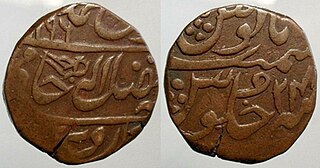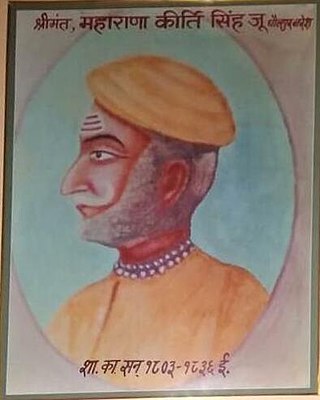
The Maratha Empire, also referred to as the Maratha Confederacy, was an early modern Indian empire and later a confederation that controlled large portions of the Indian Subcontinent in the 18th century. Maratha rule formally began in 1674 with the coronation of Shivaji of the Bhonsle dynasty as the Chhatrapati. Although Shivaji came from the Maratha caste, the Maratha empire also included warriors, administrators, and other nobles from the Maratha and several other castes from what is known today as Maharashtra. The Maratha Kingdom was expanded into a full-fledged Empire in the 18th Century under the leadership of Peshwa Bajirao I.

Chhatri are semi-open, elevated, dome-shaped pavilions used as an element in Indo-Islamic architecture and Indian architecture. They are most commonly square, octagonal, and round. Originating as a canopy above tombs, they largely serve as decorative elements as opposed to functional elements. The earliest examples of chhatri being used in the Indian Subcontinent were found in the Shrine of Ibrahim in Bhadreswar, constructed between 1159 and 1175 AD.

Dholpur is a city in the Dholpur district in Rajasthan state of India. It is situated on the left bank of the famous Chambal river. The city is the administrative headquarters of Dholpur District and was formerly seat of the Dholpur princely State of Jats.

Dhaulpur State or Dholpur State, historically known as the Kingdom of Dholpur, was a kingdom of eastern Rajasthan, India, which was founded in AD 1806 by a Jat ruler Rana Kirat Singh of Gohad. After 1818, the state was placed under the authority of British India's Jatwara. The Ranas ruled the state until the independence of India in 1947, when the kingdom was merged with the Union of India.

Mahadaji Shinde, later known as Mahadji Scindia or Madhava Rao Scindia, was a Maratha statesman and general who served as the Raja of Gwalior from 1768 to 1794. He was the fifth and the youngest son of Ranoji Rao Scindia, the founder of the Scindia dynasty. He is reputed for having restored the Maratha rule over North India and for modernizing his army.

Girdhar Pratap Singh Rana was the ruler of Gohad Jat state in Madhya Pradesh, India. He became the ruler of Gohad after the fall of Bhim Singh Rana. Rana Bhim Singh had no son. Girdhar Pratap Singh became his successor in 1755. Girdhar Pratap Singh was son of Samant Rao Balju, a family friend of Rana Bhim Singh. Girdhar Pratap Singh could not rule Gohad for long as he died in 1757. His successor was Rana Chhatar Singh (1757–1785). He was from Bamraulia gotra of Jats. He ruled Gohad state until 1757.

Kirat Singh Rana or Rana Kirat Singh (1763–1835) was a Jat ruler of Gohad state (1803–1805) in Madhya Pradesh, India. He was the founder and first ruler of Dholpur (1805–1835).

Gwalior state was a semi-autonomous Maratha state. It was centred in modern-day Madhya Pradesh, arising due to the rise of the Maratha Empire and fragmentation of the Mughal Empire.

The Gwalior Fort, commonly known as the Gwālīyar Qila, is a hill fort near Gwalior, Madhya Pradesh, India. The fort has existed at least since the 10th century, and the inscriptions and monuments found within what is now the fort campus indicate that it may have existed as early as the beginning of the 6th century. The modern-day fort, embodying a defensive structure and two palaces was built by the Tomar Rajput ruler Man Singh Tomar. The fort has been administered by a number of different rulers in its history.
Indergarh is a town and a nagar parishad in Datia district in the Indian state of Madhya Pradesh.

Maharaja Jawahar Singh was a Jat ruler of the Bharatpur State. He succeeded to the throne when his father Suraj Mal died in 1763.
Rana Pohap Singh was the Jat ruler of Dholpur state in (1836) in Rajasthan, India. He was from Bamraulia gotra of Jats. He was elder son of Rana Kirat Singh and his successor. He ruled for nine months and died in 1836. After his death his younger brother Rana Bhagwant Singh ascended to the throne.

Gohad Fort is situated at Gohad city in Bhind district of Madhya Pradesh, India. The town is situated at a distance of 45 km from Gwalior. The fort was built in 1505 by Bamraulia Jat ruler Singhandev II of Gohad State.

The history of human settlement in the western Indian state of Rajasthan dates back to about 100,000 years ago. Around 5000 to 2000 BCE many regions of Rajasthan belonged as the site of the Indus Valley Civilization. Kalibangan is the main Indus site of Rajasthan, here fire altars have been discovered, similar to those found at Lothal.
Utila Fort is a fort in Gwalior district in Madhya Pradesh, India. Utila is 20 kilometres (12 mi) east of Gwalior city on Gwalior–Hastinapur-Behat Road.
Events in the year 1707 in India.
Maharaja Chhatar Singh Rana, also known as Rana Lokendra Singh, was the 15th Jat Maharaj Rana of Gohad Kingdom. He succeeded Maharaja Girdhar Pratap Singh Rana in 1757 A.D. and ruled Gohad till 1784 A.D. He was the head of Bamraulia (Dhariwal) Jats born to Samant Rao Balju Singh of Nimrol estate, who was a relative of Maharaj Bhim Singh Rana of Gohad.

The Battle of Gwalior took place between Marathas and Kingdom of Gohad between 1754 and 1755. Marathas ultimately defeated the Jat Ruler.














